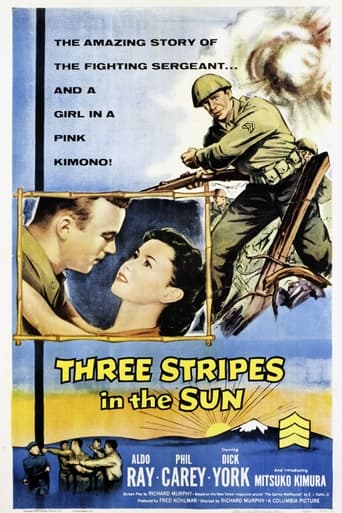

Best movie ever!
... View MoreIt’s an especially fun movie from a director and cast who are clearly having a good time allowing themselves to let loose.
... View MoreI wanted to like it more than I actually did... But much of the humor totally escaped me and I walked out only mildly impressed.
... View MoreIt's the kind of movie you'll want to see a second time with someone who hasn't seen it yet, to remember what it was like to watch it for the first time.
... View MoreWhile this wasn't an Oscar movie, I enjoyed this charming film on TCM. I find Aldo Ray a very interesting actor. He defines that 40s/50s rugged charisma (John Wayne-type) that I think lends itself well to the true story of a WWII veteran being touched by a Japanese woman and Japanese orphans. I really didn't know he had romantic leading man roles even though its a bit of a stretch for him at times. The movie is sensitive in its treatment of the cultural differences between the Japanese and Americans without being demeaning or hokey. Although the musical South Pacific touched upon similar themes, this doesn't always seem to be typical of the era.Mitsuko Kimura was very good and endearing. I wonder of her acting career listed here was actually that limited. Philip Carey, Dick Sargent and Chuck Connors all were good in their supporting roles. It's kind of funny watching Chuck Connors pitch in a charity baseball game knowing he played professionally. Even though he did not pitch in the pros, it looks like he was laying off the fastball.I also find this era in post-war Japan to be fascinating. Here you see some of Osaka and the lights of downtown Tokyo from the early-50s. It's too bad this was not filmed in color because there is some beautiful scenery around the Kyoto era.Thank you to Alana O'Reilly and the Veterans here who give this story a personal face.
... View MorePost WW II flick about soldiers in occupied Japan, helping the children of the village. Aldo Ray is sergeant O'Reilly, who starts out resenting the Japanese, but comes to appreciate them and their way of life. Dick York is O'Reilly's cohort Corporal Muhlendorf. York is one of the Dicks who will be Samantha's husband on the TV show "Bewitched", and had made only four films before this. Touching story of a soldier who befriends an orphan, and gets his outfit to help the orphans. Ray is sometimes natural in his role, and sometimes both he and York seem extra-awkward with their lines. Strong supporting roles by Mitsuko Kimura as Yuko, the interpreter, and also by Philip Carey as the all-knowing Colonel, who teaches O'Reilly several lessons along the way. One of only two films directed by Richard Murphy, who had made his mark as a Hollywood writer... and ... had just finished serving in the Air Force in New Guinea and the Philippines in 1945, so he certainly had knowledge of serving in the military in a foreign land. Ray and Carey had both also served in the military during WW II, so the cast had the right background for the post-war storyline. Solid story, if a little soapy-sudsy sweet at times.
... View MoreIn 1949 Occupied Japan, a U.S. Army sergeant who despises the locals ultimately finds a soft spot in his heart while working with the nuns and children at a bedraggled orphanage, soon falling in love with a Japanese translator. Although this story is based upon fact, with the real-life protagonist Sgt. Hugh O'Reilly acting as technical adviser, one hesitates to swallow such a big lump of sugar. The film has been designed as a heart warmer, and yet--as bullet-chested, no-nonsense Aldo Ray plays O'Reilly--the character's complete transformation into an old softy is rather too good to be true. Ray, who got stuck in a revolving door of battle films during this period, isn't an animated actor on-screen, his personality mostly consisting of a stoic manliness; here, he strains to utilize his goofy laugh and dumb-mug smile to convince us he's just a big kid on the playground (one with love in his eyes). Ray is a decent actor, but this part would be a stretch for even the most accomplished performer. Buddy Dick York gets some second-banana laughs, Phil Carey is a by-the-books colonel whose heart eventually thaws, while the sisters and little ones are constantly around to milk the audience for the utmost treacly effect. I didn't believe a minute of it. ** from ****
... View MoreThis movie was filmed in Osaka, Kyoto, Camp Otsu and around Beiwako (Lake Biwa). My commanding officer Lt. Brazil was the officer in the movie that loaned his jeep to Aldo Ray. I also had another friend in the film Dick Simonaue that played a M. P. that had a speaking part. The film was well made and showed the resentment that some of the American service men had for the Japanese. This is understandable because it took place in that period between 1945 and 1951. Most of the men there had just fought in the war and remembered how some of the Japanese soldiers killed civilians and tortured their prisoners. After a while they begin to see that the average Japanese people were not much different then ourselves. This brought about the understanding and liking the Japanese people. The picture was finished in February of 1955 and shown in the Camp Otsu theater in June of 1955. If it ever comes back to TV I would like to tape it because of the fond memories that I have of that time. Robert
... View More